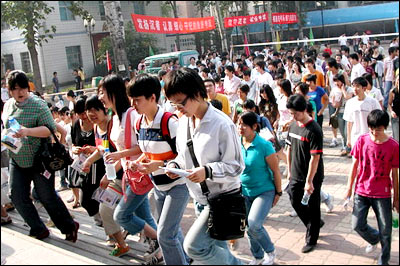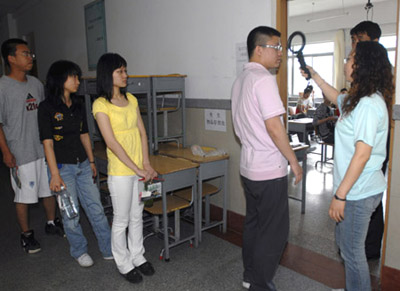| Home / Education / Photos | Tools: Save | Print | E-mail | Most Read |
| 3 Decades of College Entrance Exams Weigh Down on 10 Mln Students |
| Adjust font size: |
A record 10.1 million Chinese students have applied for this years' nationwide college entrance exam, but only 5.67 million will see their college dreams fulfilled. Except for a limited number of students who will enter colleges thanks to direct recommendations, 9.5 million people are sitting the exam today and tomorrow, the 30th since it was restored after the Cultural Revolution.
The 2-day exam has drawn the eyes of the world as it represents the only chance at higher education for most of those who sit it. Statistics from the Ministry of Education showed a record 9.52 million people applied to enter college last year, among whom 8.8 million attended the exam with 5.4 million being enrolled. This year's enrollment is set to see a slight one-percent bump. Officials with the Ministry of Education told People's Daily that a wave of new anti-cheating measures were in operation, including a national database that would provide a permanent black mark on the employment records of all those caught cheating. Furthermore, students will only be able to hand in exam papers and leave the classroom 30 minutes prior to the designated end of an exam. Previously, students could leave after a mere hour of the exam, giving them more opportunities for cheating. But in China, the dark side of this exam period is well-known. Up and down the country, teeth are gnashed, nails are bitten down to raw stubs and coffee drunk by the gallon as students cram to avoid ruining their future, or perhaps even worse, to avoid disappointing their parents. Yang Xuewei, the former director of the Ministry of Education's National Education Examinations Authority (NEEA) from 1987 to 1999, told Beijing News yesterday that he still believed the exam was the fairest way to measure a student's talent. "The exam competition among students is a symbol of social divisions. People know that workers using their minds will be better-paid and more respected than uneducated, menial laborers. Thus, the competition is furious but not over the exam itself. It is the exam results that stirs the passions, said Yang. He added that the score measure is a security for ordinary people, since without it, the rich and powerful could use their financial clout and contacts to secure the best university places for their children. Yang said the main problem facing China's education system is that high schools cannot cater to students' individual aptitudes. However, the exam will remain a part of China's university education landscape until something better could be found. "The one-time written examination is the biggest flaw of the university entrance exam," he commented. "A large-scale one-time written examination seems fair if all examinees use the same paper. However, with 10 million kids you have 10 million personalities, and the exam paper does not reflect that," Yang said. Yang Dongping, director of the Beijing Institute of Technology's Higher Education Research, looks to the future, telling Southern People Weekly that he preferred to think about "how to change the current education system." A 26-year veteran of education research, the scholar hopes to see change come swiftly. He heads up an NGO called the 21st Century Education Development Research Institute, which is set to publish an entitled "China's Education Reform Program" after several years of research. "The resumption of the national exam system 30 years ago has failed in one regard and succeeded in another," he said. "It did restore a common desire and a respect for education, but did not specify what the optimum education system would be or how it would apply to the future." He Dongchang, former head of the Ministry of Education, wrote to President Hu Jintao in 2005 about the highly-disputed examination-oriented education system. This prompted the ministry to create a vast research group on the issue but the lack of any publicized findings has led Yang Dongping to label the issue too complex to resolve. Yang advocates ensuring that the exam pressure does not trickle down to primary and secondary schools. He recommends cancelling all so-called key schools and the abolishing of high school evaluations based on the percentage of graduates that go on to university. The next step would be allowing each high school graduate to sit the entrance exam as an individual on their own merit, not as representing a certain school. The final plan would also see exam papers become more varied to reflect different kinds of universities in the future. However, as Yang's recommendations come from a civilian organization, how much influence they can carry remains in doubt.
Students wait outside a test centre in Tianshui city, Gansu Province on Thursday, June 7, 2007.
An invigilator uses a metal detector to check students as they step into the test room before the national college entrance exam in Changchun, northeast China's Jilin Province, June 7, 2007.
A girl walks into a test centre to take the ongoing National College Entrance Examination in Tianshui, Gansu Province, on Thursday, June 7, 2007.
This picture taken on June 7 shows a "no-horn" sign, which stands outside a National College Entrance Examination test centre in Beijing. Parents wait anxiously outside the examination centre, as their children take perhaps the most important exam of their life.
Students step out of the test room after an exam of the national college entrance examination in Ning'er, southwest China's Yunnan Province, which on Sunday morning was struck by an earthquake, June 7, 2007. All the 679 exam-takers in the quake-hit area took the exam Thursday. Timeline of the National College Entrance Exam 1949 Universities begin individual enrollment policy. 1950 Universities in the same region begin joint enrollment policy. 1951 Universities in a large administrative region jointly enroll students. 1952 Enrollment is standardized nationwide. 1966 "Cultural revolution" begins, marking the temporary end of the college entrance exam. 1983 The Ministry of Education implements "oriented enrollment and oriented assignment" measures. Several colleges directly affiliated to central government departments recruit students and prepare them for assignments in such fields as farming, ranching, mining or oil. 1985 Ministry of Education begins allowing universities to enroll a minority of self-funded students, with higher education now allowing self-funded and state-funded students together (dual system). China brings in standardized examination from the United States, and runs tests for English and Math in Guangdong Province. 1985-1989 The number of subjects in the exam is reduced from 7 to 5, while Shanghai maintains its 3+1 exam structure. Ministry of Education allows 43 universities including Peking University to enroll high-school-recommended students who are exempted from sitting the exam. 1989 Ministry of Education decides to slowly standardize the exam nationwide. 1996 The dual system was replaced by the single, non-state-funded, system, driving up tuition fees. Tuition fees become the norm from 2000 on, sparing the state from footing all higher education bills. 1999 Ministry of Education begins reforming the exam subjects, promoting the "3+X" plan, with Guangdong Province acting as the testing ground. 2000 Beijing, Shanghai, Anhui start spring enrollment reform, which sees the entrance exam occur twice a year instead of one. 2001 Ministry of Education announces the lifting of limitations on examinees' age or marriage status. 2002 Internet enrollment becomes mainstream with 85 percent of freshmen enrolled via the Internet. 2003 Twenty-two universities including Peking University and Tsinghua University begin self-determined enrollment, allowing more flexibility for students to choose their place of study. Furthermore, 5 percent of enrollment is left open to universities as part of the ministry’s joint plan. By 2006, the number of universities benefiting from free enrollment rights had increased to 53 with Hong Kong universities now able to recruit mainland students. 2006 Beijing and Shanghai are able to create their own alternative exam papers. Consequently, 15 different versions of exam papers appeared in China. In the same year, due to hot weather, the Ministry of Education sets the exam one month earlier than ever before. 2007 Free normal university education returns to 6 campuses under the direct supervision of the Ministry of Education as dictated by Premier Wen Jiabao in his government work report in March. (China.org.cn by Zhang Rui, June 7, 2007) |
| Tools: Save | Print | E-mail | Most Read |
 |
| Related Stories |





